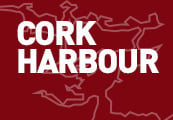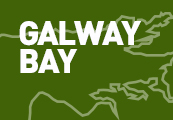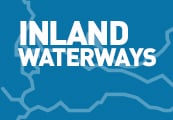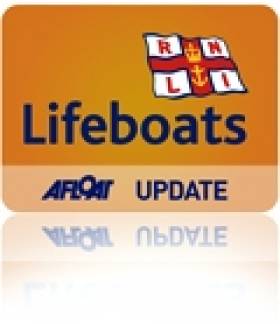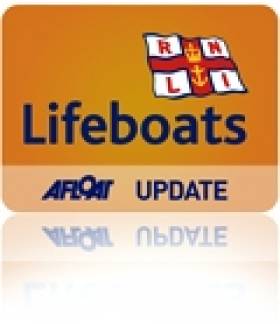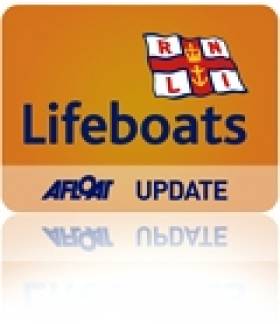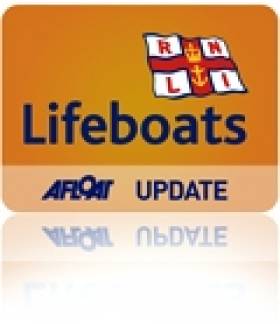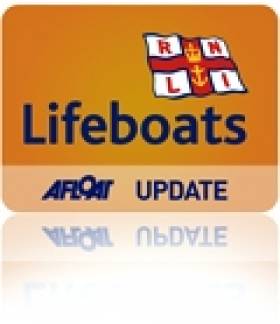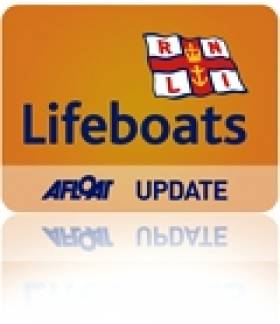Displaying items by tag: Kilmore Quay
Kilmore Quay Lifeboat Helps Fishermen To Safety After Mayday Call
#RNLI - Kilmore Quay RNLI assisted four fishermen to safety in the early hours of this morning (Friday 8 January) after they feared their vessel was in danger from taking on water.
The volunteer crew was requested to launch their all-weather lifeboat at 11.10pm last night following a Mayday call that a 13m steel fishing trawler was taking on water at Baginbun to the east of Hook Head in Co Wexford.
The four crew onboard were fishing for herring when they got into difficulty and raised the alarm. Weather conditions at the time were challenging, with a Force 8 fresh gale, a rough sea and driving rain.
The all-weather lifeboat, under coxswain Eugene Kehoe and with six crew on board, launched within minutes and made its way to the scene around 8.5 nautical miles from Kilmore Quay.
Once on scene, the lifeboat crew observed that the vessel wasn’t taking on water but that in the challenging weather conditions, some of the pound boards used to keep the fish from moving freely, had given way.
This caused a substantial amount of herring to move towards the stern of the vessel, forcing it down so that the deck level ended up in the water.
The lifeboat crew assessed the situation and contemplated transferring the fishermen onto the lifeboat. However, a decision was made to closely monitor the situation with the lifeboat moving to the weather side of the vessel to create a lee and provide shelter to the vessel before escorting it to Kilmore Quay.
The Irish Coast Guard helicopter Rescue 117 was also on scene providing essential light overhead to guide the vessel into the harbour at Kilmore Quay.
Speaking following the callout, Kilmore Quay RNLI mechanic Brian Kehoe said: "The fishermen rightly raised the alarm when they got into trouble and, taking our advice, they made a good decision given the weather conditions, to change their passage, turn around and head for Kilmore Quay with our escort.
"This was a slow process which took just over two hours in severe weather conditions but thankfully everyone was returned safely to shore."
Kilmore Quay Lifeboat Launches To American Yacht In Early Hours
#RNLI - Volunteers at Kilmore Quay RNLI were called upon to go to the aid of an American yacht with three people on board in the early hours of Wednesday 17 December.
The 42-foot yacht, which was on passage from Falmouth in the UK to Crosshaven in Cork, was experiencing difficult conditions.
The crew encountered some damage to their rigging, being forced to alter course and run before the southwest wind that was blowing at Force 6.
The yacht was 12 miles to the south of Kilmore Quay in Co Wexford at 11pm when its crew put in a call to the Irish Coast Guard for help.
Kilmore Quay’s all-weather lifeboat Killarney left the harbour at 11.15pm and was alongside the yacht 35 minutes later.
A tow rope was passed to the yacht and its was towed back to the marina at Kilmore Quay, arriving in at 2.30am.
Boating Visitors To Ireland's South Coast Get Mixed Welcome Messages
#marinetourism – Ireland's south coast provides an almost infinite variety of harbours, natural havens, and extensive areas of interesting sailing water. These cater for boat enthusiasts of all kinds, with craft of every type. So how does the welcome for visitors shape up? W M Nixon contrasts the different hospitality styles of four attractive ports.
The word on the grapevine that the Ballydehob Old Boat festival had taken place arrived with an intriguing photo from Anthony O'Leary. It had been noted in the interview with him immediately after he had led the team in Ireland's Commodore Cup Victory, that while he was trying to unwind for a while, it's not really in the O'Leary makeup to relax, and soon his mind was busy with new ideas of nautical interest.
Nevertheless he was cruising gently in early August down towards West Cork in the family's handsome big Nelson powercruiser Irish Mist, a fast and able vessel which his father Archie and mates like Mick Ahern once took right round Ireland in a settled springtime spell of weather, just to be in Dublin to watch Cork Con play rugby in some major championship at Lansdowne Road.
As it turned out, this year Irish Mist was getting down west ultimately to be in Baltimore for the 1720 Nationals in late August, which O'Leary duly won. But from time to time, he flashed back some photos of interesting boats met along the way, and one which really rang the bell was a little Ette Class clinker-built gunter-rigged sloop sailing in Castlehaven.
The Ette class originated way way back, when two keen dinghy cruising types sailed their little dinghy into Castlehaven, and the Castletownshend locals in the South Cork Sailing Club were so taken by the boat that they commissioned the waterfront boatbuilders, the O'Mahony brothers, to build some sister ships as the basis of a class.
All the new boats' names ended in "ette". And the class survived for many years, though at times the Ettes were hanging on by a thread. But recently it has had a fresh lease of life with new examples of what is now a classic dinghy being built by Lui Ferreira of Ballydehob, who last came through this parish when, in 2012, he put the first teak deck on a vintage Howth 17, the syndicate-owned Deilginis.
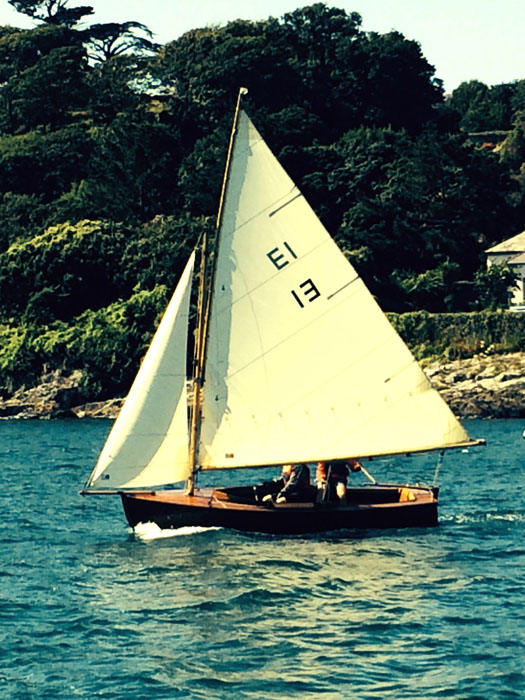
Perfection of summer – an Ette class in her home waters of Castlehaven. Photo: Anthony O'Leary
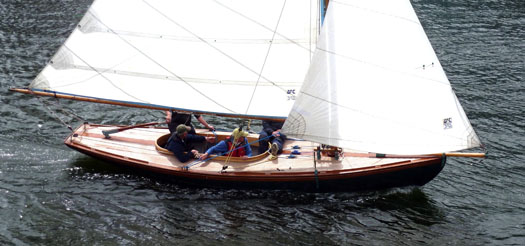 Rui Ferreira, builder in Ballydehob of the Ette Class, also put this teak deck on the 107-year-old Howth 17 Deilginis in 2012. Photo: W M Nixon
Rui Ferreira, builder in Ballydehob of the Ette Class, also put this teak deck on the 107-year-old Howth 17 Deilginis in 2012. Photo: W M Nixon
A Howth 17 looks well no matter how you photo her. But an Ette is a quirky little thing which can sometimes look odd from the wrong angle. Yet in a flash of inspiration, the Captain of the Commodore's Cup team took up his iPhone as an Ette came bustling down Castlehaven on fine sunny morning, and we got what I reckon to be one of the best photos of an Ette under way ever obtained – plus it gets the very essence of summer in Castlehaven.
The next O'Leary snap some days later was just briefly titled: "The Ballydehob Old Boat Festival, Irish Mist in archway second left". What was going on here? We'd heard vague stories about a very relaxed assembling of boat at high water at the drying quay at Ballydehob, but the O'Leary photo hinted at serious numbers and a high level of organization.

The teaser photo – first intimations of this year's Ballydehob Gathering of the Boats, with the O'Leary family's motor-cruiser Irish Mist (framed in the second arch from left) joining an eclectic group of 74 boats for a couple of hours at top of the tide. Photo; Anthony O'Leary
 This is most people's image of Ballydehob, crowded and very rural, with Mount Gabriel beyond. Only the more observant will notice the tidal river in the foreground. Photo: W M Nixon
This is most people's image of Ballydehob, crowded and very rural, with Mount Gabriel beyond. Only the more observant will notice the tidal river in the foreground. Photo: W M Nixon
To begin with, most casual visitors would scarcely think of Ballydehob as a seaport at all. Rather, it's the very essence of rural West Cork, a crowded little village where "laid-back" is the default mode, and it has been so for some time. It reached something of an apotheosis when Annie Barry (she's one of the Fergusons of Gubbeen Cheese) was running her wonderful Annie's restaurant on one side of the winding main street, and the Levis sisters Julia and Nell, feisty little ladies of mature years, were running Levis's pub across the way.
Julia and Nan were splendid folk of considerable standing, and it's said the pair of them were once squired to the West Cork Hunt Ball in Skibbereen by Jeremy Irons of Kilcoe Castle a few miles along the coast. As for the setup in Ballydehob, space was so limited in the restaurant that, having checked out your booking, you simply took up station in leisurely style across the street in the pub with Annie's menus and an aperitif or two, then Annie would come across the road and discuss your order, and a delightful evening would continue late into the night.
Alas, for some year now Annie's has been closed, though everyone lives in hope of somebody re-opening it. And in the pub, the old ladies have passed on. But now it's run by a great-nephew, and very successfully too. We got ourselves in there late on a velvet July evening this year to find the place was heaving with youth and beauty and high fashion in casual style - achingly trendy it has become.
It could have been a traditional local in any of the world's fashionable holiday areas except for one thing. A ball of fur, a terrier of some kind, emerged from among people's legs and barked its head off at me. I assumed it was because I carried a whiff of our own little Jack Russell. But the blushing girl owner told me with a big smile that her little dog must have thought I was a priest. Only along Ireland's south coast, near some former or still surviving Protestant enclave, would you have heard that particular excuse.
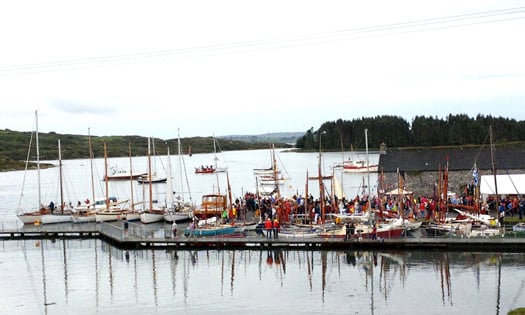 The old dock at Ballydehob is well able to receive a very varied fleet, seen here from the old railway viaduct Photo: Miriam Jones
The old dock at Ballydehob is well able to receive a very varied fleet, seen here from the old railway viaduct Photo: Miriam Jones
Just along the river from these scenes of hospitality and minor mayhem, immediately below the mighty railway viaduct which seems to be so disproportionate for the long-gone needs of the little West Cork Railway, there's Ballydehob Harbour. Time was when it was key to the place's economy, and it was in the late 1930s, only a year or so before World War II, that the Brooklands, the last surviving sail-only coasting schooner to deliver cargoes to West Cork, made her way up the winding estuary at the head of Roaringwater Bay (it's named for the Roaringwater River, much of the bay behind Carbery's Hundred Isles is well sheltered), to anchor just off the quay, as she was too deep to berth alongside.
The Brooklands was owned and skippered by Tom Creenan of Ballinacurra in the inner northeast reaches of Cork Harbour, but it was from Birkenhead or Goole on the Mersey that she'd bring her welcome cargoes of coal, a challenging passage at the best of times. At Ballydehob, while smaller cargo-carriers could get alongside the old quay, the Brooklands discharged her cargo into the multi-functional barge-type vessel known the Sandboat.
She was used by her owners, the Levis family, for just about everything, but primarily for going out among the islands towards high water, running up on a clean beach, then laboriously shovelling sand into the hold until the tide returned and the Sandboat could be floated off and piloted back to the quay where her eventually very useful cargo would be shovelled ashore to become builders' supplies.
The Sandboat was Queen of the Fleet at Ballydehob, and she played such a central role in the Levis family's life that Old Boat Festival organiser Cormac Levis's brother calls his pub in Ballydehob the Sandboat.
As for how Cormac himelf first got the notion for the Ballydehob Gathering of the Boats, he has been a tower of strength in the Traditional Boat movement, particularly in West Cork but also throughout Ireland, for many years. And with others following his example in restoring or even building new sailing lobster boats to traditional design, he suggested that getting together at Ballydehob during the little town's time-honoured summer festival around August 15th might hit the spot. And for the first one in 2004 –making this year's the tenth anniversary - they assembled nine boats, which was considered pretty good going.
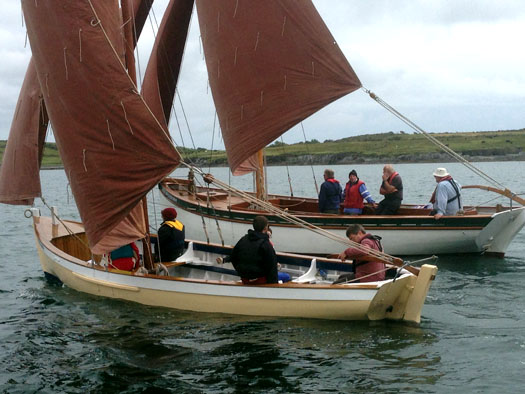
Close-up on Cormac Levis's lobster boat, which led the way for the first gathering of traditional craft at Ballydehob in 2004. Photo: Brian Marten
From it, they learnt that, for the future, while the aspiration would of course be for quiet and easy-going organization under a light hand, underneath it all there'd have to be efficiency, always with an eye on the clock. Although the tidal window is more than two hours for most boats, they've successfully accommodated modern yachts up to two metres draft without anyone being left behind stuck on the mud. But with limited manoeuvring space in both the harbour area and the channel, once the witching hour of high water is upon the fleet, it's time to start thinking about an orderly departure after two solid hours and more of good crack, mighty barbecues, and much interest in an examination of other people's traditional and classic boats.

Even among the sister-ships of the lobster fleet, many individual variants in hull lines and rig are apparent. Photo: Brian Marten

Just to add to the variety and colour, the Ilen Trust from Limerick brought their much-travelled Shannon Gandelows (right) to Ballydehob. Their stylish pennants are a legacy of heir successful visit to Venice at the end of April this year. Photo: Gary MacMahon
So the crucial thing is to select the ideal Saturday nearest to August 15th with a good big tide in mid-afternoon. As the Boat Gathering is such a force in its own right, they can range quite extensively on either side of August 15th, and to date the earliest has been August 8th, while the latest was August 21st.
This year's was Saturday August 9th, and while there may have been rain later in the day despite West Cork having much more sunshine in August than almost any other part of the country, no-body now remembers the rain as they recall the sheer fun and sense of community of what has been described by Tiernan Roe, another of the quality boat-builders of Ballydehob, as the "shortest bestest Boat Festival in the World".

Yet another creation of the active Ballydehob boat-building scene. This is an attractive little Cape Henry 21 cutter lunched in June by Tiernan Roe of Roe Boats. Photo: Tiernan Roe
For this year, it attracted 75 boats, though admittedly last year's record entry of 50 boats was greatly enhanced by this year's decision by the Drascome Lugger Association to combine Ballydehob in their 2014 cruise-in-company in West Cork, thereby adding 27 boats at a stroke.
But even with 27 boats of one class, the variety across the fleet as a whole was remarkable. So how do they assemble such a disparate fleet of boats with obviously highly-individual skippers, in such a quietly efficient way? For you'll never see or hear the Ballydehob Gathering of the Boats being publicly advertised all that much beforehand.
The method is perfectly simple. Everyone with an interest will know it is likely to be coming up on the agenda. So a month and more beforehand, Cormac will text them with the final date on a need-to-know basis. It works, and it sets the tone of quiet consideration for others and their boats in a very special festival in which some quiet sponsorship by CH Marine and West Cork-based German traditional boat fan Thomas Drewes sees that all participants get mementoes including cherished T-shirts (definitely not for general release), while barbecue facilities keep the good humour buzzing until everyone departs in style for their anchorage for the night, for although most boats hope to be berthed in Ballydehob on the big day more two hours hours before high water, once the ebb has started the channel has become much less forgiving about any pilotage errors.
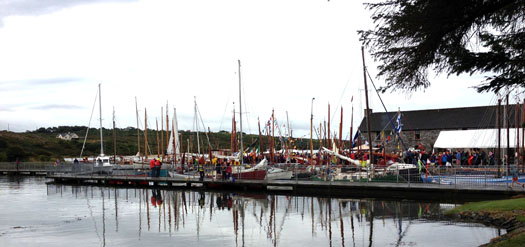
They're all here, as neatly berthed as you could please, but getting them away as the ebb starts requires good seamanship and boat-handling skills. Photo: Miriam Jones
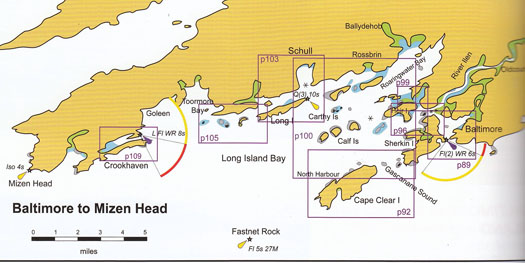
Ballydehob's central position in a hugely varied and welcoming crusing coast is emphasized by the number of other harbour chartlets indicated in this plan of the prime cruising area of West Cork. Plan Courtesy Irish Cruising Club
It's good to see a locally-focussed event like this now coming of age with a very healthy turnout. Eastward along the south coast, last weekend saw another event which will surely grow in stature and numbers, the second staging of Y2V Cruise-in-Company on the River Blackwater up the estuary from East Cork to West Waterford, as a flotilla of ten boats - eight GP14s, a Mermaid and a Feva – sailed up-river from Youghal to Villierstown.
It has been promoted by Youghal schoolboy GP 14 skipper Adrian Lee, and last year the inaugural tiny flotilla managed most of the sailable river by going to the bridge at Cappoquin before returning downriver to Villierstown. This year it achieved deserved support from the GP 14 class, with the furthest road-trailed from sea level being incoming Irish GP 14 Association President Stephen Boyle from Sutton DC, while the furthest-travelled in terms of elevation above sea level were the Blessington group, who came down from the Wicklow Hills with their Geeps and included Richard Street and kids (see again this blog on 26th July), and a brand new Duffin boat belonging to Simon Culley and Libby Tierney.
As for seniority, the classic of the class was a 60-year-old beautifully-restored Bell Woodworking GP 14 owned and skippered by 16-year-old Jack Nolan, another of that group of Youghal youngsters who are taking local dinghy sailing forward with gusto, while further variety was provided by Norman Lee of Greystones, his crew including the inevitable family pooches which are such a part of the GP 14 scene.
The sailing was mixed – as Norman said, in a river the wind will always be ahead some time, and though we think of the secret Blackwater Estuary as being fairly straight, in fact there are some quite significant curves. It took about four-and-a-half hours to sail up, and a brisker four hours to return on Sunday morning's ebb.
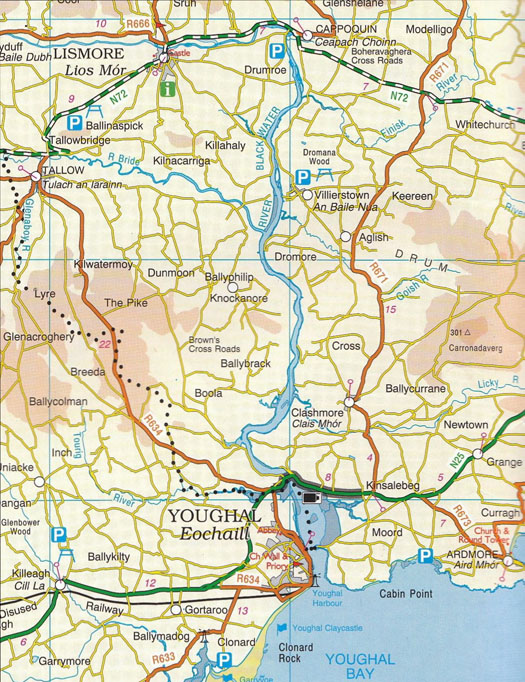
The secret waterway – the Blackwater Estuary from Youghal up to Cappoquin and almost to Lismore is one of Ireland's least-sailed rivers

Villierstown's new clubhouse, open only three weeks, was ready and willing to make welcome the crews who had sailed up from Youghal. Photo: Norman Lee

The new facility, Villierstown's "floating pier"
(right), was originally the in-harbour pontoon at Dungarvan SC. Photo: Norman Lee
At Villierstown, the new clubhouse of the Villierstown Boating & Activites Cub had been open only three short weeks, but they've made good use of a sports council grant, and it well fulfills a multi-purpose role, including providing the hospitality needed by sailing campers, with Paul Virtue and his wife Caroline organising a fine feast in the clubhouse on the Saturday night, and an enormous breakfast on Sunday to send them on their way downriver to round out an event which has future annual success written all over it.
One of the reasons it all went so well was that the slightly cogglesome little plastic floating jetty, along which the sailors of Villierstown used to access their small boats, has been replaced by a proper pontoon which the club acquired when Dungarvan SC eastward along the coast up-graded their in-harbour pontoon. In fact, Dungarvan support for the development of Blackwater sailing didn't stop there, as one of the fleet in the Y2V was a vintage Dungarvan-based Mermaid in which owner Eugene Burke has cruised the entire south coast between Ballycotton and Kilmore Quay.
The boat is Akita, Mermaid No. 85, and she has certainly been around, as she was built in the Barkyard in Skerries in 1953 by Joe and Matt Boylan. The Barkyard was originally the place where the Skerries-based coasting schooners and fishing boats had their sails preserved against rot by tanning with bark, but in the 1950s the now redundant premises were used to build some of the eventually enormous fleet of Skerries Mermaids through a boat-building class run by the colourful Jem Kearney.
The Fingal region around Skerries and Rush continues to be the great heartland of the Mermaids, with some very racy boats built in the old mill at Rogerstown recently, but despite the modern challenge, this year's Mermaid Week at Rush saw the champion emerge in the form of Jonathan O'Rourke of the National YC with his vintage boat, one of the few Mermaid sailors still in Dun Laoghaire.

The welcoming port. Despite its tidal limitations, Dungarvan lays on the welcome in a big way. This shows a visiting fleet at the original pontoon, which has now been moved to Villierstown. Photo Kevin Dwyer, courtesy Irish Cruising Club
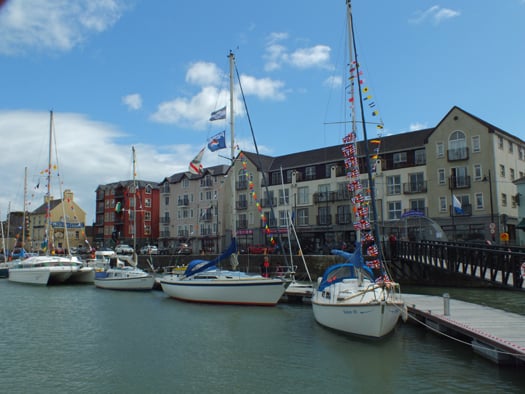
Dungarvan SC's new in-harbour pontoon has much improved the alongside berthing space, but unfortunately the local Council wouldn't permit dredging to improve access.......Photo: Donal Walsh

....and thus the reality for most boats in the Inner Harbour is a drying berth.......... Photo: W M Nixon
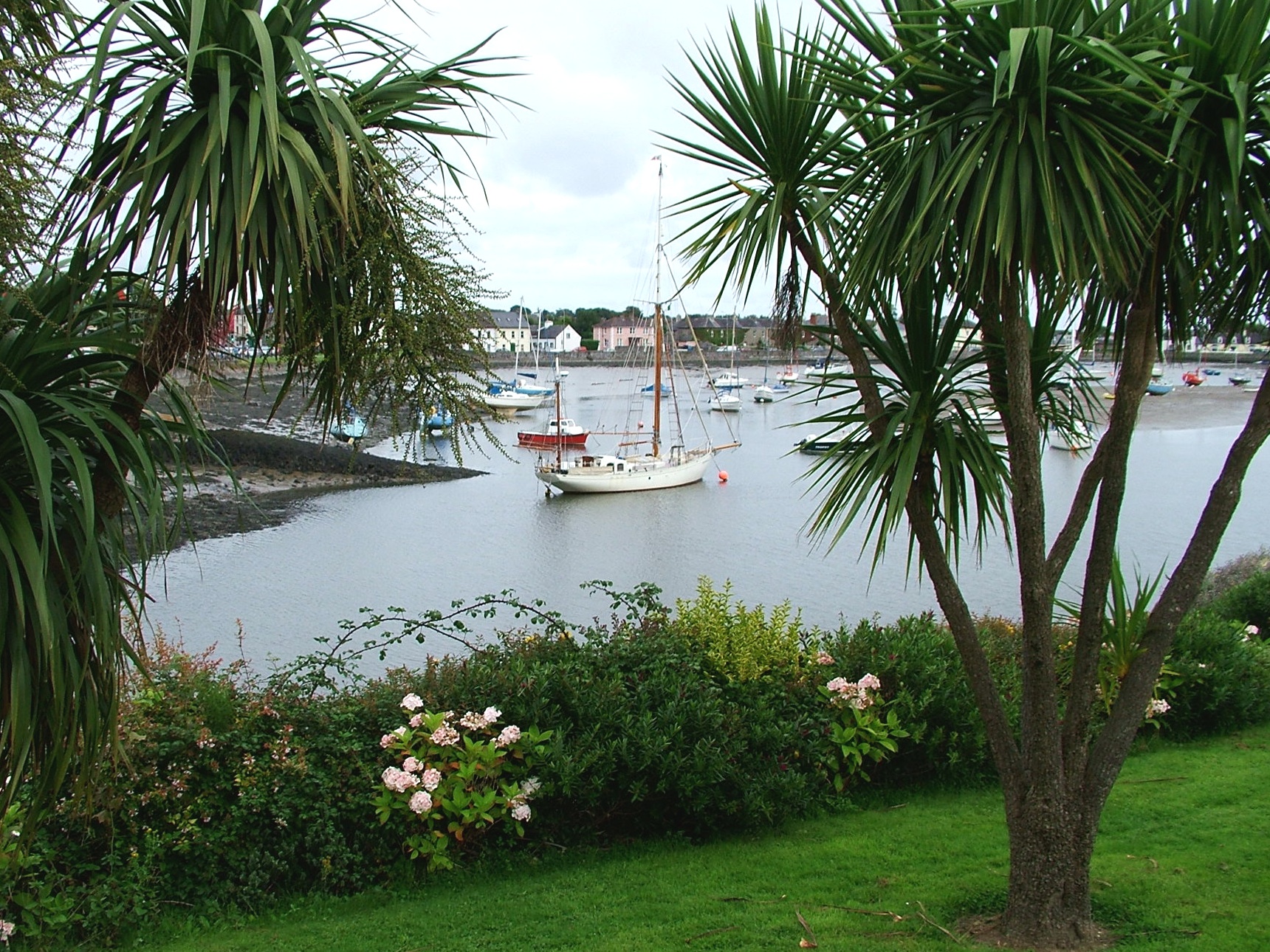
....but if you've access to local knowledge, there is a deep pool just below the bridge........Photo: Donal Walsh
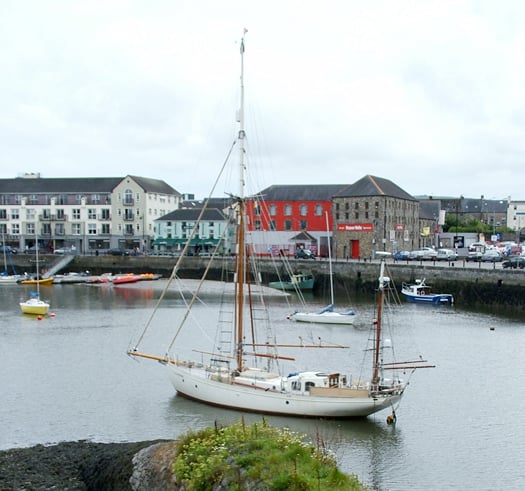
.....and here the Northwest Passage transiting 44ft steel gaff yawl Young Larry is visiting in comfort and style. Photo: Donal Walsh
Meanwhile in Dungarvan the club's hopes of doing a bit of dredging to improve access to their extended in-harbour pontoon was stymied when the council said they wouldn't permit any salt-contaminated sludge being brought up onto the quay. But despite its tidl limitations, it's a hugely hospitable place, and if you do take the ground at the pontoon, it's mostly soft and forgiving mud which enables you to sit in relative comfort. Certainly some very substantial cruising boat have overnighted here to enjoy the fine pubs both on the waterfront waterfront and in the town, while culinary standards are set by Paul Flynn's famous restaurant The Tannery just round the corner.
Nevertheless if you absolutely won't let your boat dry out, leading Dungarvan cruising man Donal Walsh (he has just returned from an epic round Ireland and Britain clockwise cruise with his Moody 31 Lady Kate) well knows the deep pool across the harbour close under the bridge, and he saw to it that his brother-in-law Andrew Wilkes and sister Maire Breathnaith found a secure berth there for their hefty 44ft steel-built gaff yawl Young Larry, a boat in which they transited the Northwest Passage, but she looks well at home in Dungarvan with its fine tradition of first class locally-based trading schooners.
In moving along the south coast, we find that when possible, they'll lay out the welcome mat big-time in Ballydehob, Youghal, Villierstown and Dungarvan, despite the fact that all four places are restricted in what they can do by the exigencies of tide.
So how are things working out in Dunmore East, the one port which has the potential to be one of the most welcoming and accessible all-tide sailing and fishing ports along the entire south coast?
Despite this potential, the under-development of its facilities, fuelled by a sometimes poisonous attitude between fishermen and other harbour users, has provided recreational visitors with often unpleasant memories. In trying to understand why this might be so, we have to understand how Dunmore East came to get its pretty little harbour. When it was built in the first half of the 19th Century, it was not – as is commonly supposed – built for the benefit of fishermen. The horrible fact is that fishermen came so far down the pecking order that they just had to make do for themselves as best they could.
The handsome new pier at Dunmore East, designed by Alexander Nimmo who is best known for developing Tobermory in Scotland and many places in Galway including Roundstone, was constructed exclusively for the use of the new fast sailing cross-channel packet boats serving the top people of Waterford in their trading and communication with Britain, while the unfortunate local fishermen were forced to keep their boats in the limited shelter of The Cove to the north of it, and haul them on the exposed beaches at The Strand and Councillors Strand.
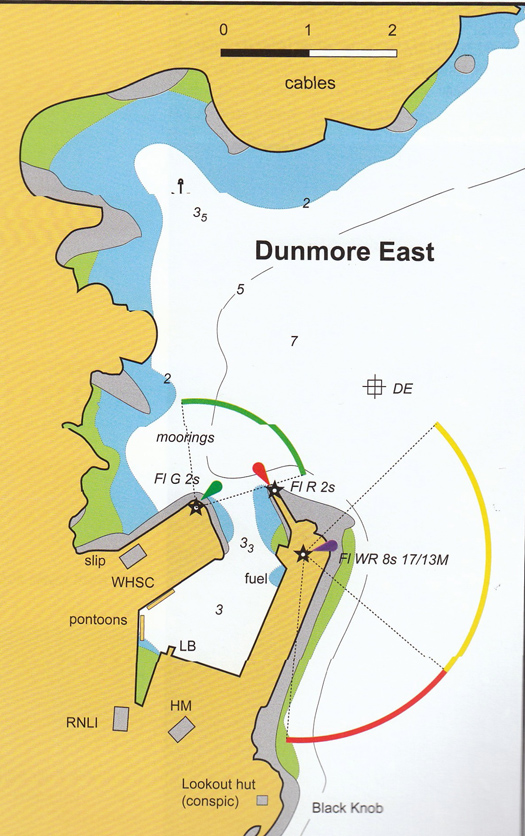
Dunmore East's substantial pier was new-built originally to provide a port for cross-channel sailing Packet Boats, serving Waterford ten miles up the road. When this was its primary function, any local fishermen were banished to the poorly-sheltered coves to the north, with their boats being hauled up on the exposed beaches beyond. Plan courtesy Irish Cruising Club
Soon, however, steam driven packet boats were able to go conveniently all the way up to Waterford, and Dunmore East was redundant as a packet-boat harbour. But it was only with reluctance that fishing boat were allowed to start using it, as the Royal Navy would have been keeping an eye on its possibilities for their own occasional use.
Yet down the years, the idea has developed that Dunmore East was always primarily a fishing harbour, and to a lesser extent the same attitude prevailed at Howth on the east coast, where the new harbour functioned as the Packet Boat station for Dublin only between 1817 and 1826, when the developing new asylum harbour at Dun Laoghaire became the selected port for the Royal Mail's new paddle steamers serving the cross-channel route. Yet the silted harbour at Howth was only allowed to become a "fishing station" in the 1850s.
The legacy of all this, in Dunmore East at any rate, is that there still seems to be a suspicion among the fishing community that their tenure is only temporary, that the powers-that-be would move them out if they see a better use for the place. How else can we explain the negative and almost paranoid attitude of the fishing spokesmen every time a suggestion for a much-needed marina at Dunmore East is put forward?
With all this in mind, I made a quick visit to Dunmore East in mid-August while on other business in the southeast, in the hope of seeing if a much-trumpeted €4 million dredging scheme was now in progress in the harbour, and also to see how an equally celebrated new Visitors Pontoon along the East Pier was working out.
The photos speak for themselves. There wasn't any sign of a dredger, though doubtless that will turn up in due course. Yet as for the 40 metre pontoon, it's not a leisure-boat-friendly neat little piece of work at all, but is quite a massive and brutal steel box structure more suited to rugged fishing boats, who were showing their approval by using it so totally that the only leisure visitor was a German motor-cruiser which had managed to squeeze in at one end.
But as this pontoon is on the wrong side of the harbour for ease of access to the Sailing Club on the west side, and the welcoming facilities in the village above it, any pedestrian boat visitor – the vast majority of incoming leisure boaters, in other words – has a long trek through the sometimes crowded and malodourous delights of a fishing port before they can access any amenities. So not surprisingly the German boat had its inflatable tender moored outside it for quick and easy movement across the harbour, and along to the beaches if wished, a situation which inevitably precluded any other newly-arrived boat from rafting up alongside
So for any cruising boat coming in from sea, often with the challenge of Hook Head just recently put astern, it wasn't a welcoming setup. In fact, it was downright hostile. While we were there, an ordinary sailing cruiser with happy folk aboard came motoring from the eastward to round the end of the pier after stowing their sails, but their hopes of a convenient and enjoyable visit to Dunmore East were soon dashed. No welcoming RIB came out from the sailing club to direct them to a vacant mooring, as there probably wasn't one. And as for the pontoon, "unwelcoming" is inadequate. It clearly didn't want anything to do with them. You could see their spirits wilting as they headed out, faced with the long haul up to the marina in Waterford City. The current visitor berthing situation in Dunmore East is at the very least a sad business, so where does it go from here?

Dunmore East in mid-August. No sign of any dredging, and the "Visitors Pontoon" under the lighthouse on the East Pier is packed out with fishing boats.......Photo: W M Nixon
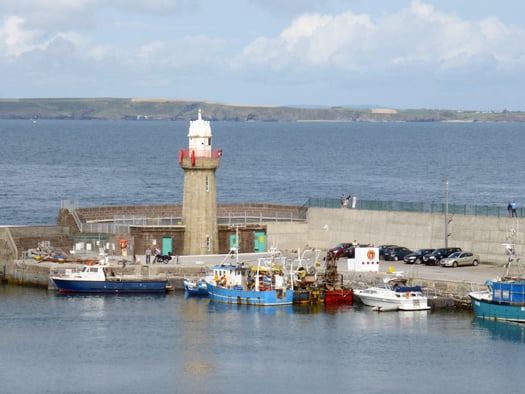
........and just one visiting German motor cruiser which was protected against any rafting up by its tender on the outer side. Photo: W M Nixon

The new pontoon is an industrial standard piece of kit......Photo: W M Nixon
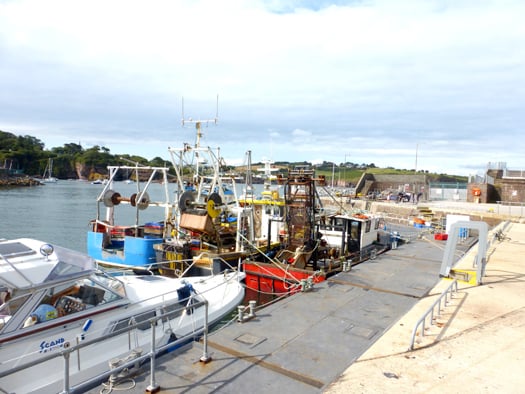
....and understandably very popular with active fishing boats. Photo: W M Nixon

But for visiting sailing boats newly arrived in port.......Photo: W M Nixon
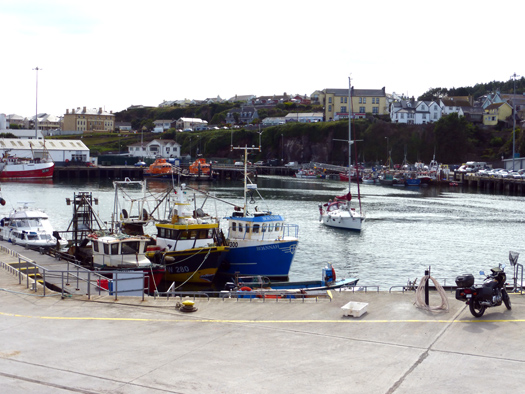
....it's soon clear that there isn't really a welcoming berth for them.....Photo: W M Nixon
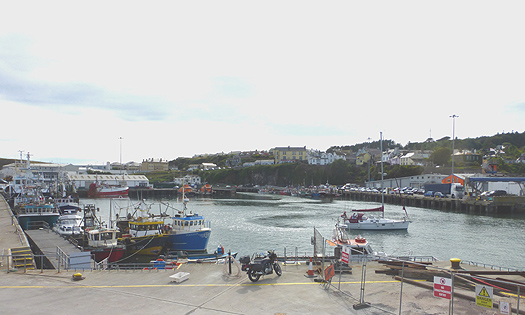
....and they head out to sea again, visibly disappointed by their Dunmore East welcome. Photo: W M Nixon
#dieselforboaters – The problem of lack of fuel supplies around the Irish coast just got a little bit easier with the news that the popular south coast marina at Kilmore Quay in County Wexford has installed a new diesel fuel oil facility. The new equipment dispenses filtered low sulphur marked gas oil. Payment for the service can be made by credit and debit card. The self service system is available on a 24/7 basis and available to all harbour users.
More information from Marine Officer, Captain Phil Murphy, Wexford County Council, email :[email protected], Tel 053 9129955 (Kilmore Quay) / 9122300 (Wexford Harbour) and Fax 053 9129915.
Kilmore Quay Lifeboat In Christmas Day Surfer Rescue
#RNLI - Kilmore Quay RNLI volunteers had a Christmas Day call-out last week when a surfer got into difficulties just before 4pm.
The man had been surfing at the Burrow Shore off the Memorial Garden to the west of the Co Wexford lifeboat station when he drifted towards the rocky end of the beach, where it would have been dangerous for him to come ashore.
Weather conditions were good at the time, with a light north-westerly breeze with an on-shore swell, good visibility and overcast sky - so the lifeboat crew had no problems responding swiftly, taking the lifeboat’s Y-boat to recover the surfer and his board.
No medical assistance was required and the surfer and his board were landed safely back at the marina.
The Kilmore Quay surfer was just one of hundreds who took to the wintry waters around the coast as Christmas Day saw an array of special events nationwide, from surfing in Strandhill to swimming in Sandycove.
As the Irish Independent reports, locals at Banna Beach in Co Kerry were treated to the incredible sight of 300 people running into the freezing Atlantic in a charity challenge for the local sea rescue unit.
And in Dublin, the traditional Forty Foot plunge brought out its regular contingent of hardy souls.
Kilmore Quay & Wicklow RNLI In Separate East Coast Assists
#RNLI - Kilmore Quay RNLI has assisted a fisherman after his boat got into difficulty off the Wexford coast, while Wicklow RNLI attended to a fishing boat in trouble south of Wicklow Harbour.
The Kilmore Quay all-weather lifeboat was requested to launch at 9.04am on Monday morning (29 July) to go to the assistance of a local lobster boat with one person on board,
The fishing boat had fouled its propeller while hauling pots a mile to the south-east of the Little Saltee Island.
Weather conditions at the time were blowing a light southerly breeze and there was good visibility.
When the lifeboat arrived on scene, a tow was set up and the vessel was brought safely to the harbour at Kilmore Quay.
Shortly afterwards, Wicklow RNLI launched at 9.30am in response to a call for assistance from a fishing vessel in difficulties six miles south of Wicklow Harbour.
The vessel with three crew was fishing north of Brittas Bay beach when a rope got fouled in the propeller and she lost steering. The skipper contacted the coastguard for assistance.
Wicklow town's lifeboat, under the command of coxswain Nick Keogh, located the vessel drifting close to the Wolf Rock 20 minutes after launching.
A towline was quickly established and the stricken vessel was towed back to Wicklow Harbour, where she was secured safely alongside the East Pier at 10.40am.
The crew on the call out were coxswain Nick Keogh, mechanic Brendan Copeland, Tommy McAulay, Kevin Rahill, Carol Flahive, Paul Sillery and Graham Fitzgerald.
#RNLI - The volunteer lifeboat crew at Kilmore Quay RNLI in Co Wexford had a busy time last week with five call-outs in seven days.
In the first incident on Monday 13 May, a French 6.5m yacht with two people on board got into difficulty as it was taking part in a 'mini Fastnet' yacht race.
The vessel’s crew decided to make for Kilmore Quay due to adverse weather. The yacht had no engine due to race rules and so the lifeboat was reqested to help the crew safely get into the harbour.
The second call-out came last Wednesday evening (15 May) when a member of the public reported to Dublin Coast Guard that a yacht was close in shore and flashing a light.
As the lifeboat crew were letting go the ropes, the coastguard made contact with the vessel, which was at anchor and did not require any assistance.
On Friday afternoon 17 May, the volunteer crew was alerted when an 8m pleasure craft with two people on board had fouled its propeller a quarter mile off the South Head of the Great Saltee Island.
The vessel was freed by the lifeboat crew using a grapnel hook and cutting the rope before towing the boat back to Kilmore Quay Marina.
And last Sunday 19 May saw two shouts which were similar in nature.
The first in the morning involved a small leisure craft with four people on board which suffered engine failure. The crew was relying on a mobile phone for their communications and combined with poor English, it made the task of finding them more challenging.
The crew members were eventually located to the west of the Saltees and were brought back ashore safe and well.
Later the same day, another small leisure craft - this time with three people aboard and again relying on a mobile phone for their communications - had lost power while fishing at the south side of the Little Saltee Island.
The lifeboat was on scene a short time later and towed the vessel back to Kilmore Quay.
Three Overdue Divers Brought to Safety By Kilmore Quay Lifeboat
Three divers were brought to safety this afternoon after they lost contact with their dive boat and were reported overdue. The men were brought to safety by volunteer lifeboat crew with Kilmore Quay RNLI.
The divers were over an hour and a half late resurfacing when their dive boat skipper called for help at approximately 1.30pm. They had been diving at the Conningmore rocks, one mile south of the Saltee Islands in Wexford, when they failed to appear. Conditions were described as good and the sea state was calm.
The search commenced immediately with Kilmore Quay RNLI being joined by the Coast Guard helicopter Rescue 117 from Waterford and two local charter vessels. The men were quickly spotted by the helicopter crew who in turn alerted the lifeboat to their exact location.
The divers had drifted almost three miles away and had lost contact with the dive boat. The lifeboat crew recovered the three men onto the lifeboat. The first was taken onboard with a Jason's cradle, a piece of lifeboat equipment used to aid recovery of people from the sea. Then the lifeboat crew lowered the stern ramp and threw out a line to pull in the remaining two divers. They then made their way back to Kilmore Quay harbour. The men were in good spirits and did not need any medical assistance.
Commenting on the callout Aidan Bates, a volunteer crewmember with Kilmore Quay RNLI said, "This is a beautiful spot for diving and is very popular with dive groups. The dive boat skipper did exactly the right thing in reporting the men overdue and happily we were able to recover them safely onto the lifeboat. They were certainly relieved to see us coming and we were delighted to be able to bring everyone home safe."
Station To Station Challenge Raises More Than €2,000 For RNLI
#RNLI - Two men who embarked on the first RNLI Station to Station challenge between Bundoran and Arranmore last Saturday (6 April) completed the job in just under 12 hours - raising over €2,000 for both lifeboat stations in the process.
As per their plan reported previously on Afloat.ie, Niall Clancy and James McIntyre both set off from Bundoran Lifeboat Station just after 6am on Saturday morning – Clancy running and McIntyre cycling.
Clancy's route took him through Bundoran, Ballyshannon, Donegal town, Mountcharles, Frosses, Glenties, Gweebarra Bridge, Lettermacaward, Dungloe, Burtonport and finally Arranmore Island via a treadmill on the ferry!
He was joined on various legs of the journey by members of the Tir Chonaill Athletic Club who kept his spirits up on the 100km journey from station to station.
Meanwhile, McIntyre and his team from Mullaghmore Triathlon Club and Donegal Bay Cycling Club took off at the same time cycling as far as Lough Eske, where James then made the lonesome journey himself across the Bluestack Mountains, constantly keeping organisers informed of his progress via text message.
Down into Glenties and from there by bike to Portnoo where, with Bundoran RNLI crewman Killian O’Kelly, he kayaked the remaining 22km to Arranmore Island, where both he and Clancy were greeted by the lifeboat crew and the Arranmore Pipe Band.
Speaking on completion of the challenge at Arranmore RNLI Lifeboat Station, Clancy said: "It’s been a long but great day. The weather conditions couldn’t have been any better for both myself and James – though it was very cold this morning leaving Bundoran!
"I’m looking forward to a few weeks off training before I get back into it for the Athlone Half Ironman in August."
McIntyre added: "We’d both like to express our gratitude to everyone who supported us ahead of the challenge and today – particularly those who sponsored us and those who ran and cycled with us today, our support teams, our chefs, the RNLI crews and sponsors Ormston’s Mace Ballyshannon and All Sports Donegal Town."
Shane Smith, volunteer lifeboat press officer for Bundoran RNLI, said: "We are thrilled at the success of the challenge and delighted that over €2,000 has been raised for both stations.
"We are indebted to James and Niall for their selfless support of our charity and would like to thank them sincerely on behalf of both crews."
Elsewhere, a Wexford family who organised a sponsored swim in memory of a loved one and former volunteer have raised a whopping €5,000 for Kilmore Quay RNLI.
The Hayes family presented the cheque to the RNLI at Kilmore Quay lifeboat station recently, funded by a sponsored swim on St Stephen’s Day organised by the family in memory of the late Paddy Hayes, who was a volunteer with the lifeboat.
Kilmore Quay Marina. Yacht & Boat Berths & Storage in Wexford
Kilmore Quay is located in the south east corner of Ireland. A small fishing village situated approximately 14 miles from the town of Wexford and 12 miles from Rosslare ferry port. Its 55 berthed marina, offers shelter from the elements as well as various on shore facilities. Kilmore Quay is a regular port of call for many cruising yachtsmen. With several nearby areas of either historical or natural significance accessible using local bike hire, Kilmore Quay is renowned for its 'green' approach to the environment.
Kilmore Quay, Wexford, Ireland
Tel: 00353 53 912 9955 Fax: 00353 53 912 9915
Email: [email protected]
www.wexford.ie


